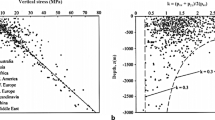Conclusions
Thus, the completed studies have made it possible to develop a technology and methodology, based on the compensation method, for measuring the load on the edges of inter-chamber pillars. An experimental-theoretical method has also been proposed for estimating the residual life of such pillars in excavated sections of potassium mines.
The results of full-scale measurements established that the edge regions of interchamber pillars located near the boundary of a cave-in (region of chamber 103 in our investigation) are in the supercritical state. For a subsidence rate of 1.5 mm/day at the surface, the residual life of such pillars is estimated to be 7–8 months.
The zone loaded by bearing pressure from the caved-in rock is shifted toward the interior of the goal (regiona of chamber 120). The load factor of the pillars exceeds the allowable value [C]=0.4 specified by standards for “rigid” interchamber pillars in the mines of the Verknekamsk Potassium Salt Deposit, which accounts for their “compliant” regime of deformation. Thus, to reduce the strains of the water-protective stratum and prevent water above the deposit from entering the mine, the region of chamber 120 must be filled.
Similar content being viewed by others
References
V. Vitke, Rock Mechanics [in Russian], Nedra, Moscow (1990).
N. P. Blokh, Stress Measurement in Supporting Rock [in Russian], Nedra, Moscow (1995).
V. L. Vodop’yanov and I. Kh. Gabdrakhimov, "Stress state of carnallite pillars in the Solikamsk Mine," Tr. Permsk. Nauchn. Issled. Ugol’nyi Institut, No. 6 (1964).
V. E. Marakov, Improvement in Methods of Designing the Structural Elements of the Chamber System Used to Mine Potassium Beds of the Verkhnekamsk Deposit: Author’s Abstract of Engineering Sciences Candidate Dissertation. Perm (1997).
V. A. Solov’ev (ed.), Procedural Manual for Mining Operations in the Mines of the Verkhnekamsk Potassium Deposit. Nedra, Moscow (1992).
A. M. Lin’kov, "Stability during the weakening of rocks over time," Fiz. Tekh. Probl. Razrab. Polezn. Iskop., No. 1 (1989).
A. M. Lin’kov, I. M. Petukhov, and M. A. Tleuzhanov, "New methods of designing pillars," ibid., No. 3 (1984).
G. N. Fallageev, Rheological Properties of Rocks and Their Correlation with Principal Physico—Mechanical Characteristics: Author’s Abstract of Engineering Sciences Candidate Dissertation. Frunze (1990).
Additional information
Mining Institute, Ural Branch of the Russian Academy of Sciences (Perm). Translated from Fiziko-Tekhnicheskie Problemy Razrabotki Poleznykh Iskopaemykh, No. 1, pp. 18–25, January–February, 1998.
The theoretical part of this investigation was completed with financial support from the Russian Fund for Basic Research, Grant No. 96-05-64849.
Rights and permissions
About this article
Cite this article
Baryakh, A.A., Asanov, V.A., Toksarov, V.N. et al. Evaluating the residual life of salt pillars. J Min Sci 34, 14–20 (1998). https://doi.org/10.1007/BF02765520
Received:
Issue Date:
DOI: https://doi.org/10.1007/BF02765520




